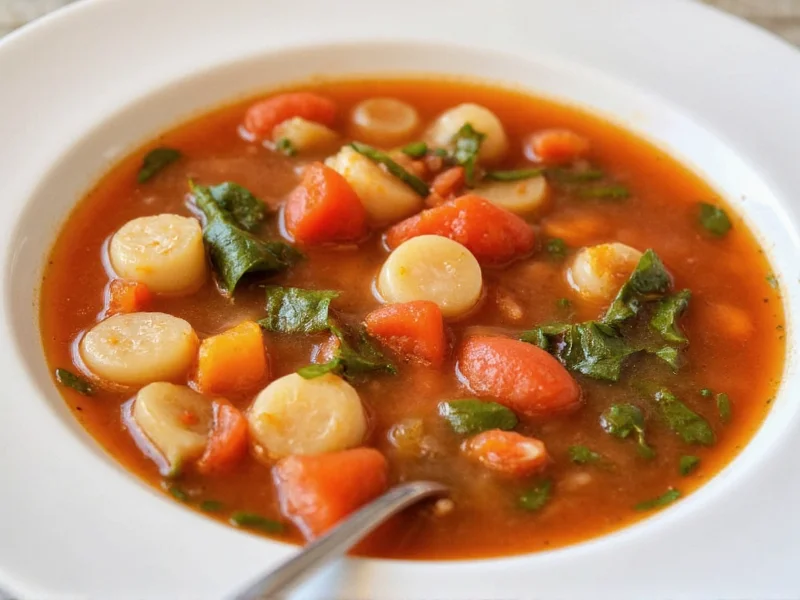Minestrone soup represents Italy's culinary philosophy: transforming humble ingredients into nourishing comfort food. Originating in rural farmhouses, this 'soup of all vegetables' varies by region and season but always centers on fresh produce, beans, and pasta simmered in a rich tomato broth. Unlike many modern versions that rely on canned shortcuts, authentic minestrone builds flavor through careful layering of ingredients and proper cooking technique.
Essential Minestrone Soup Ingredients
Traditional minestrone uses seasonal vegetables, but these core components create the signature flavor profile. The soffritto (onion-carrot-celery base) forms the flavor foundation, while pancetta or olive oil provides richness depending on your dietary preference.
| Category | Ingredients | Quantity | Preparation |
|---|---|---|---|
| Aromatics | Yellow onion, carrots, celery | 1 medium onion, 2 carrots, 2 celery stalks | Fine dice (1/4 inch) |
| Tomato Base | Canned tomatoes, tomato paste | 1 (28oz) can, 2 tbsp | Crushed by hand |
| Beans | Cannellini or borlotti | 1 (15oz) can, drained | Rinsed thoroughly |
| Greens | Kale or spinach | 2 cups chopped | Stems removed |
| Pasta | Ditalini or small shells | 1/2 cup | Uncooked |
| Liquid | Vegetable broth | 6 cups | Low sodium preferred |
Step-by-Step Minestrone Soup Preparation
Follow these professional techniques for restaurant-quality minestrone every time. The key to depth of flavor lies in properly developing each component before combining.
Building Flavor Foundations
Heat 2 tablespoons olive oil in a 5-6 quart Dutch oven over medium heat. Add the diced soffritto (onion, carrots, celery) and 1 teaspoon salt. Cook for 8-10 minutes until vegetables soften but don't brown. This gentle cooking releases natural sugars without caramelization that would overpower the delicate vegetable flavors.
Stir in 2 tablespoons tomato paste and cook for 2 minutes until it darkens slightly. This 'blooming' process eliminates raw tomato flavor and creates umami depth. Add 1 cup of broth to deglaze the pot, scraping up any browned bits from the bottom.
Simmering to Perfection
Add the remaining 5 cups broth, 28oz crushed tomatoes, 1 (15oz) can rinsed beans, 1 zucchini (diced), and 1 medium potato (peeled and diced). Bring to a gentle boil, then reduce heat to low. Cover and simmer for 20 minutes until vegetables are tender but not mushy.
Stir in 1/2 cup uncooked ditalini pasta and 2 cups chopped kale. Simmer uncovered for 10-12 minutes until pasta is al dente. The soup should have a hearty but not thick consistency - add more broth if needed. Remove from heat and stir in 2 tablespoons pesto (optional) and freshly cracked black pepper.
Authentic Minestrone Variations
Traditional minestrone changes with the seasons and region. In Liguria, they add pesto; Tuscany features cavolo nero (black kale); Northern regions often include rice instead of pasta. For a summer version, replace potatoes with fresh green beans and add basil flowers. Winter minestrone benefits from butternut squash and extra root vegetables.
For gluten-free minestrone, substitute small quinoa or rice for pasta, adding it during the last 15 minutes of cooking. Vegan versions work beautifully by using olive oil instead of pancetta and nutritional yeast instead of Parmesan.
Serving and Storage Tips
Minestrone tastes best when allowed to rest for 24 hours, letting flavors fully meld. Serve in pre-warmed bowls with a drizzle of extra virgin olive oil, freshly grated Parmesan, and crusty bread. The soup thickens as it sits, so have additional broth ready to adjust consistency when reheating.
Store in airtight containers for up to 5 days in the refrigerator or freeze for 3 months. Never add pasta to portions you plan to freeze - it will become mushy when reheated. Instead, cook fresh pasta separately and add to individual servings.
Troubleshooting Common Issues
Too thin? Simmer uncovered for 10-15 minutes to reduce, or blend 1 cup of soup and return to pot. Too thick? Add broth 1/4 cup at a time until desired consistency. Bland flavor? Balance with 1 teaspoon lemon juice or red wine vinegar to brighten flavors. Vegetables too soft? Add heartier vegetables (potatoes, carrots) at beginning and delicate ones (zucchini, greens) in last 15 minutes.











 浙公网安备
33010002000092号
浙公网安备
33010002000092号 浙B2-20120091-4
浙B2-20120091-4